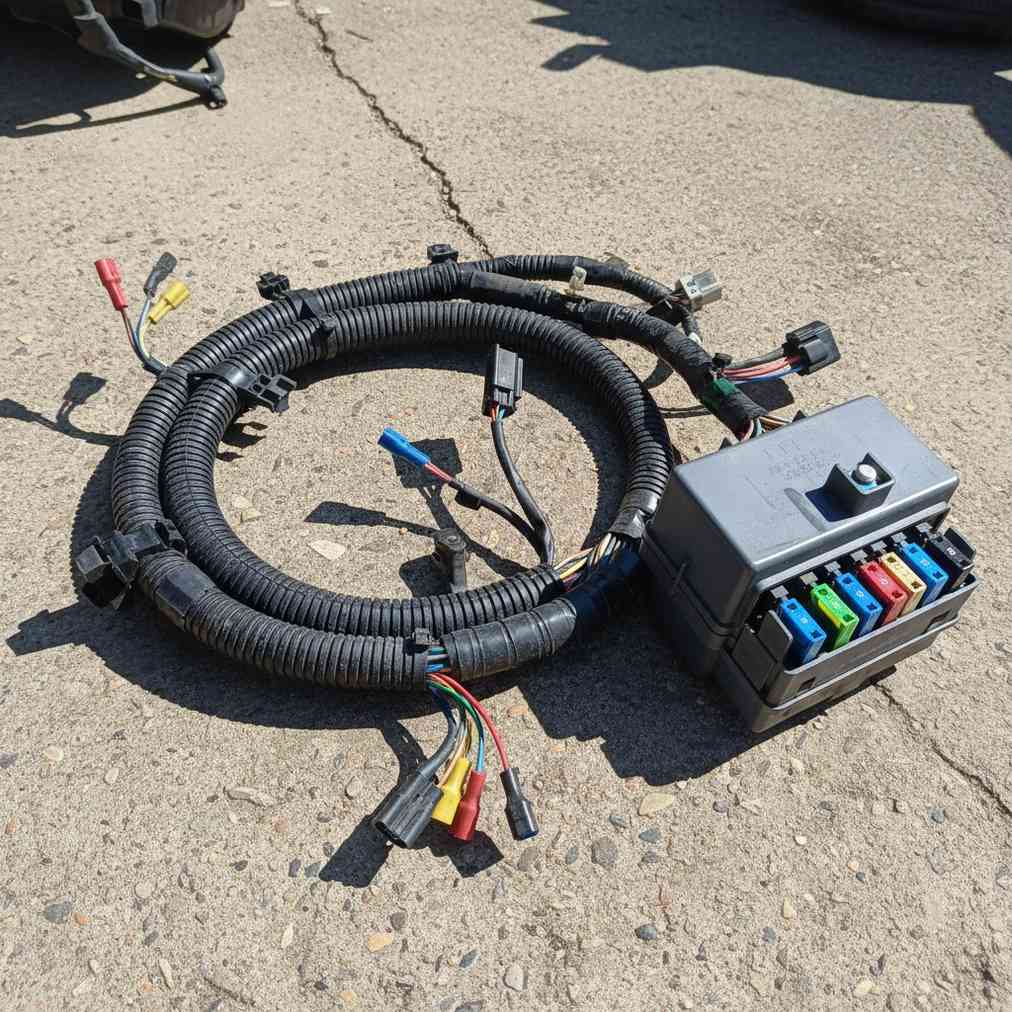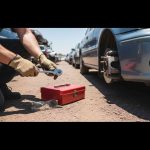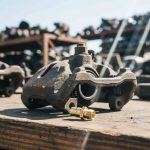Why OEM Wiring Harnesses Are Pure Gold in Salvage Yards
The automotive salvage industry holds many treasures, but few are as valuable and overlooked as OEM wiring harnesses, pigtail connectors, and fuse boxes. These electrical parts represent a goldmine for savvy salvage yard visitors who understand their true worth. While most people focus on engines and transmissions, smart scrappers know that intact electrical parts can command premium prices in the resale market.
The demand for used, high-quality OEM electrical parts continues to grow among restorers, custom builders, and DIY mechanics seeking significant cost savings compared to purchasing new parts. Understanding how to identify, remove, and properly store these valuable parts can transform your salvage yard visits from casual browsing into profitable treasure hunts.
Understanding the Market Value of Used Electrical Parts
The salvage market for electrical parts thrives on several key factors that make these items consistently valuable. Cost savings represent the primary driver, as new wiring harnesses can cost hundreds or even thousands of dollars, making used OEM alternatives extremely attractive at a fraction of the price.
- OEM Quality Advantage: Original factory harnesses offer exact fit and function as intended by manufacturers, often superior to aftermarket replacements
- Budget-Conscious Builds: Essential for restoration projects and custom builds where every dollar matters
- Environmental Benefits: Reusing these parts reduces landfill waste and manufacturing demand
- Active Trading Market: Platforms like eBay feature thousands of listings for used harnesses, cables, and connectors
High-value electrical parts frequently sought after in salvage yards include engine management modules, complete wiring harnesses, specialty switches, and integrated fuse boxes. These parts maintain their value because they’re essential for vehicle operation and often expensive to replace with new alternatives.
Identifying Premium Wiring Harnesses Worth Your Time
Not all harnesses offer equal value, and knowing how to spot the premium ones can mean the difference between profit and waste. The highest value comes from harnesses that are intact, undamaged, and from desirable vehicles with strong aftermarket demand.
| Quality Indicator | What to Look For | Red Flags to Avoid |
|---|---|---|
| Wire Insulation | Soft, pliable, no cracking | Brittle, cracked, or melted sections |
| Connector Condition | Tight connections, clean pins | Corrosion, loose fit, missing clips |
| Labeling | Clear OEM markings intact | Rubbed-off printing, aftermarket labels |
| Overall Appearance | Neat, organized, no tampering | Cut wires, splices, amateur repairs |
Harnesses for engine swaps, particularly popular conversions like GM LSx swaps, command premium prices. Additionally, harnesses for classic vehicles or hard-to-find repairs on older models are particularly valuable. Trusted resellers often test harnesses using multimeters to verify continuity, voltage, and proper power flow before listing them for sale.
Professional Removal Techniques for Maximum Value Preservation
Careful removal is absolutely essential to preserve the value of harnesses and connectors. The key principle is avoid simply cutting everything apart – instead, focus on clean depinning and complete section removal with plugs intact.
Step-by-Step Connector and Harness Removal Process
The goal of professional removal is depinning individual wires from connectors or carefully extracting entire sections with their plugs intact. This process requires patience and the right tools, as demonstrated in various automotive wiring tutorials available online.
- Research and Preparation: Study the donor vehicle’s wiring layout before visiting the yard, checking online inventory when available
- Identify Connector Types: Different manufacturers use specific connector styles (Delphi, Deutsch, etc.) requiring appropriate tools
- Remove Secondary Locks: Many connectors have colored secondary locks that must be gently removed first using picks or small flat tools
- Unlock Primary Latches: Locate the primary locking tab securing the terminal inside the connector housing
- Use Proper Pin Removal Tools: Specialized tools or improvised options like straightened paperclips work for gently releasing locking tabs
“The critical step is ensuring the locking tab is completely released before pulling the wire. Forcing it will separate the wire from the terminal, destroying the value.”
For fuse boxes, the removal process requires extra care due to their complexity. Disconnect all attached harnesses systematically, noting mounting points and connection sequences. These units often integrate multiple systems and can be challenging to replace properly without detailed documentation.
Proper Storage and Preparation for Resale
Post-removal care maintains the integrity and marketability of your harvested electrical parts. Professional storage techniques can significantly impact the final selling price and customer satisfaction.
- Immediate Labeling: Document connections before removal, especially for complex harnesses you might reference later
- Thorough Cleaning: Remove dust, grease, and residue from harnesses and connectors using appropriate cleaners
- Terminal Inspection: Check depinned wires for terminal condition, gently adjusting locking tabs for proper reinstallation
- Proper Storage Environment: Store in dry, cool locations to prevent corrosion and maintain insulation integrity
- Protective Packaging: Avoid tight packing that might crush delicate connectors or damage wire insulation
High-Demand Electrical Parts and Their Market Values
Understanding which electrical parts command the highest prices helps prioritize your salvage efforts. Research shows that specific parts consistently perform well in the resale market due to their critical function and replacement cost.
| Part Category | Typical Resale Value | Market Demand | Best Sources |
|---|---|---|---|
| Engine Harnesses | $150-$800 | Very High | Late model vehicles, performance cars |
| Body Control Modules | $75-$300 | High | Luxury vehicles, modern cars |
| Pigtail Connectors | $10-$50 each | Consistent | Common failure points |
| Fuse Boxes | $50-$200 | Steady | Integrated units preferred |
Engine swap harnesses represent the premium end of the market, particularly for popular conversions. These specialized harnesses often sell for 60-80% less than new alternatives while providing identical functionality. The market for these parts continues growing as more enthusiasts pursue engine conversion projects.
Tools and Equipment for Professional Electrical Part Recovery
Success in harvesting valuable electrical parts requires the right tools and equipment. Professional-grade tools not only improve efficiency but also prevent damage that could destroy a part’s resale value.
- Pin Removal Tool Set: Specialized tools for different connector types
- Pick and Probe Set: For accessing tight spaces and releasing secondary locks
- Digital Multimeter: Essential for testing continuity and functionality
- Wire Strippers and Crimpers: For making clean connections when necessary
- Magnetic Parts Tray: Prevents loss of small connector pieces and pins
- Headlamp or Flashlight: Adequate lighting for detailed connector work
Quality tools pay for themselves quickly when you can recover intact, functional parts that sell for premium prices. Many successful salvage professionals invest in professional-grade electrical tools that withstand regular use and provide consistent results.
Common Mistakes That Destroy Electrical Part Value
Understanding what not to do is just as important as knowing proper techniques. Many potentially valuable parts get ruined by common mistakes that could easily be avoided with proper knowledge.
- Cutting Instead of Depinning: Destroys connector integrity and eliminates resale value
- Forcing Stuck Connectors: Breaks locking mechanisms and damages housing
- Ignoring Secondary Locks: Leads to pin damage and incomplete removal
- Poor Storage Practices: Allows corrosion and physical damage during storage
- Inadequate Testing: Selling non-functional parts damages reputation and reduces future sales
Professional salvage operations emphasize training and proper technique to maintain the value of recovered parts. This attention to detail separates successful operations from those that struggle to realize the full potential of their inventory.
Building a Profitable Electrical Parts Business
For those serious about turning electrical part recovery into a profitable venture, understanding the complete business cycle from acquisition to sale is essential. Success requires consistent quality, reliable testing, and strong customer relationships.
Many successful electrical parts dealers started by purchasing vehicles specifically for part recovery, focusing on models known for valuable electrical systems. This targeted approach allows for systematic recovery of multiple valuable parts from each vehicle.
- Market Research: Understanding which parts have consistent demand
- Quality Assurance: Testing all parts before listing for sale
- Proper Documentation: Maintaining records of part numbers, compatibility, and testing results
- Customer Communication: Providing detailed descriptions and honest assessments
- Competitive Pricing: Balancing profit margins with market competition
The electrical parts market rewards consistency and reliability. Customers who find a trusted supplier often become repeat buyers, especially when they know the parts are properly tested and accurately described. Building this reputation takes time but creates sustainable long-term profits.
Future Trends in Electrical Parts Salvage
The electrical parts salvage market continues evolving with automotive technology advances. Understanding these trends helps position your salvage efforts for future success and identifies emerging opportunities.
Modern vehicles contain increasingly sophisticated electrical systems, creating new categories of valuable salvage parts. As vehicle technology advances, the complexity and value of electrical parts continue increasing. Research methodologies for understanding market trends become increasingly important for staying ahead of demand.
- Advanced Driver Assistance Systems: Cameras, sensors, and control modules
- Infotainment Systems: Complete units and specialized harnesses
- Hybrid/Electric Vehicle Parts: Battery management systems and charging equipment
- Connectivity Modules: Telematics and communication systems
The salvage industry adapts to these changes by developing new techniques for safely recovering and testing advanced electrical systems. This evolution creates opportunities for those willing to invest in learning new technologies and acquiring appropriate testing equipment.
Maximizing Your Electrical Parts Recovery Success
Success in electrical parts recovery combines knowledge, proper tools, careful technique, and market understanding. The most successful practitioners treat it as a skilled trade requiring continuous learning and adaptation to changing technology and market demands.
The electrical parts salvage market offers significant opportunities for those willing to learn proper techniques and invest in quality tools. Whether you’re an occasional hobbyist or considering this as a business venture, the principles of careful removal, proper storage, and honest dealing will serve you well in this specialized market.
Remember that building expertise takes time, but the investment pays dividends through higher recovery rates, better part quality, and ultimately higher profits. The “junkyard gold” is there waiting for those who know how to find it and extract it properly.





Leave a Reply
You must be logged in to post a comment.